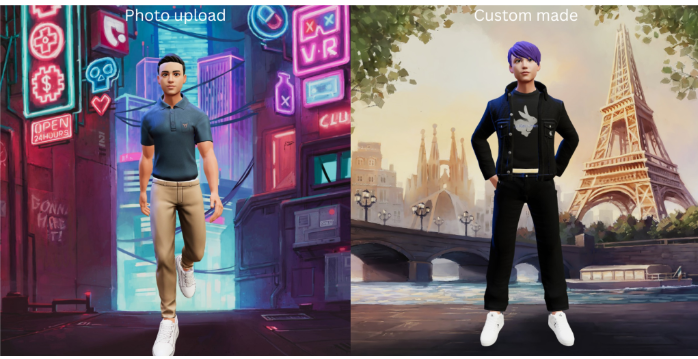As more of our interactions occur in the metaverse, from social meetups for recreation to business meetings, this avatar will become our online persona. It will become us; therefore, the Proteus Effect will play a vital role.
The Proteus Effect
Back in 2007, researchers at Stanford University found that people with taller or more attractive avatars behaved differently in the virtual world than their cohorts in the study. Specifically, they displayed more intimacy-sharing behavior and were more confident. The researchers concluded that these behavior changes were directly related to the users associating their identity with the avatar, a phenomenon they labeled the Proteus Effect.
Proteus, Who?
Proteus was a Greek god who could shift forms at will — just one of several mythological characters from around the globe that held this power to transform their appearance. Others include Shiva in ancient India, Loki in Norse mythology, and the Raven in Native Northwest American cultures.
So, the transformation theme has been part of many cultures, and we see that reflected in our superhero movies. Therefore, it’s natural that, given the option, metaverse users will want to create avatars that transform & represent them.
The Implications of the Proteus Effect
The Proteus Effect changes what psychologists call our self-perception, which is how we see ourselves in relation to the outside world. It influences how we feel about ourselves and interact with others. Digital technologies, including the metaverse, impact our self-perception, and as we communicate using avatars, it may change our behavior.
The ability to reinvent yourself, once reserved for supernatural beings and parlor games, is now becoming an aspect of daily reality. Over time, more interactions may move into the digital realm. How much will the Proteus Effect change and influence human behavior in this new landscape? The truth is, it’s hard to know for now.
A 2019 meta-analysis of 46 studies on the Proteus Effect found that it is indeed a “consistent” and “reliable” phenomenon. It’s happening right now as users create avatars and navigate the metaverse in their new, customized, and optimized identity. And just as changing your appearance affects how you feel and, therefore, how you interact in the real world, there is now a new opportunity for addressing the same consumer demand in the virtual world.
Show Me the Money
RPM recently announced it had raised more than US$56M to bring its total funding to US$72M. In addition to hiring, they plan to expand the platform with more developer tools, including those for monetization and more services for creators. They plan to double down on creating interoperable avatars and identities that can be used across multiple virtual environments.
There is an opportunity to cater to the self-perception enhancement effect that avatars engender. But while many companies are still experimenting with how that will happen, several large real-world companies have already jumped on the bandwagon.
Brands in Metaverse
L’Oréal recently signed an agreement with RPM to create makeup looks and hairstyles for their avatars. Similarly, Tommy Hilfiger has a partnership with RPM to bring their gear to the metaverse. While these agreements greatly expand branding for the companies, they also aim to produce future revenue.
Sneaker companies have also been the first group of serious investors to move money and interest into the metaverse. Adidas released it’s own “Into the Metaverse” NFT collection in 2021. They partnered with the Bored Ape Yacht Club and NFT influencer Gmoney to create more virtual offerings and host metaverse classes within the Adidas app. Nike acquired the digital sneaker maker Rtfkt and is releasing special edition shoes with customizable skins modeled after those in the metaverse.
Gucci has also entered the metaverse market. A virtual version of their Dionysis handbag recently sold for even more than the real-world original on Roblox. The platform allows you to build and buy clothing, accessories, and more for — you guessed it — your metaverse avatar.
There are many instances of brands working in partnership with metaverse platforms to mention in this post. The examples give an idea of possibilities.
The Future of Avatars in Virtual Reality
So how significant will the Proteus Effect be for the future of the metaverse? We spend money on things in the physical world that make us feel good and confident about ourselves. Why should our digital self be any different?
As we increase our time in immersive environments and see our peer groups with custom avatars, how we feel about our representation may start to matter.
Impact on Social VR
For Social VR companies, tapping into the power of the Proteus Effect could be an essential driver of user engagement and revenue.
Here is a quick Reddit poll to see if VRChat users are willing to pay for an avatar. It’s only a subset of Social VR users, so the insights drawn are directional.
The results show that a good proportion of users (44%) plan to make custom avatars themselves using 3D tools or pick available avatars. So, the tools that enable these users and make it easier to create custom avatars should be a priority for Social VR companies.
The remaining (56%) would pay others to make a custom avatar, so monetization tools and a marketplace could drive more creators toward the platform. I also recommend reading the comments from users for more insights.
Conclusion
For Brands and Social VR platforms, how avatars impact self-perception could be the key to creating engagement and positioning themselves to stay ahead for future success in the metaverse. And that’s why we are here to help – Contact us today and let’s get started!







